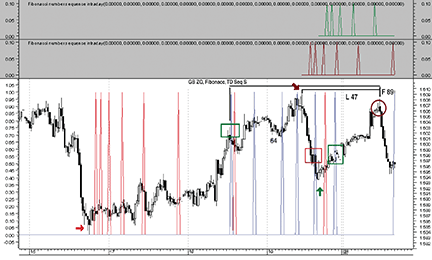TRADING SYSTEMS
More Time-Based Trading Techniques
TD Sequential And Ermanometry
For Intraday Traders 
You can automate time-based techniques to apply to intraday charts. In the first part of this series, we discussed Fibonacci’s bar-counting technique and the Lucas number series. This time, we will examine two others: the TD Sequential and Ermanometry.
Time-based techniques are effective and can be applied to intraday trading, but unless they are automated, they require a great deal of tending and tracking on the part of the trader. The Fibonacci and Lucas techniques, which we explored in the previous issue, can be mechanized (as seen in that article), but they will not continue to plot without further input. This is also true of William Erman’s Ermanometry, which we will look at later in this article. Meanwhile, Thomas DeMark’s TD Sequential can be automated without requiring further input, as we will see here.
TD Sequential
In his book Day Trading Options as well as in various articles, Thomas DeMark demonstrated that his TD Sequential and TD Combo bar counting techniques are equally effective on intraday charts. However, there are many trading platforms that have not coded the indicators, and their manual calculation still presents a challenge for a busy daytrader.
It’s beyond the scope of this article to discuss DeMark’s two indicators in detail. Suffice it to say that TD Combo anticipates price exhaustion within trends, as does the countdown component of the TD Sequential. The setup component of TD Sequential focuses on the momentum component to define price ranges. Thus, if a directional move continues after the momentum component is complete, TD Countdown and TD Combo can be applied to identify areas of trend exhaustion.
However, as Jason Perl stresses in his recent book about DeMark’s indicators, the momentum component is still important, since how the market responds to a setup determines whether it is range-bound. Each time price completes a setup, the price extremes are identified by a support and resistance line known as the TD Setup Trend (Tdst). If price fails to break through the Tdst, there is an opportunity to take a contrary position insofar as the market doesn’t have the momentum to start the countdown phase — that is, to break through the Tdst into a new distinct trend. This means that a mechanized version of the setup is capable of creating many interesting signals of its own.

Figure 1: 30-minute chart of british pound december 2010 futures. Here you see a red Fibonacci series and DeMark’s setup in blue. The upper panes contain further Fibonacci series launched from more recent turning points.
Disclaimer
The computer code published on this webpage and in the September 2011 issue of this publication reflects the efforts of third parties to code the indicators discussed in the following article, published in the September 2011 issue of Technical Analysis of Stocks & Commodities: Andrew Coles, ‘TD Sequential and Ermanometry for Intraday Traders.’ The code published on this webpage or in the September 2011 issue of Stocks & Commodities is not sponsored or endorsed by, nor affiliated in any manner whatsoever with, Thomas DeMark or his company, Market Studies LLC, and it should not be confused with any indicator, software, product or service that he or his company may offer, or license others to offer, for purchase or licensing.